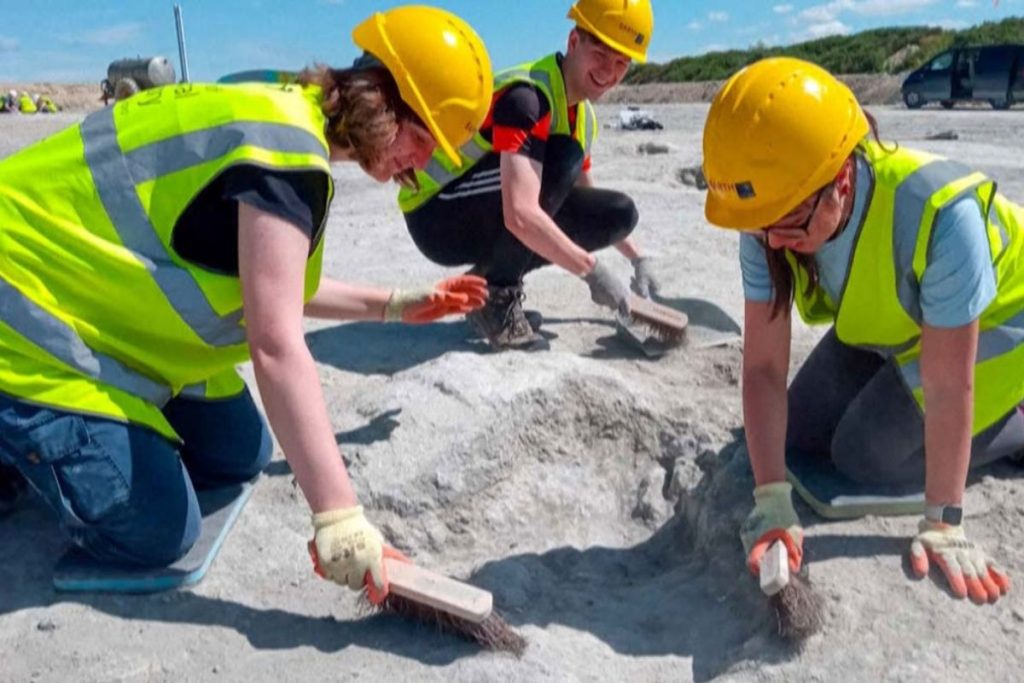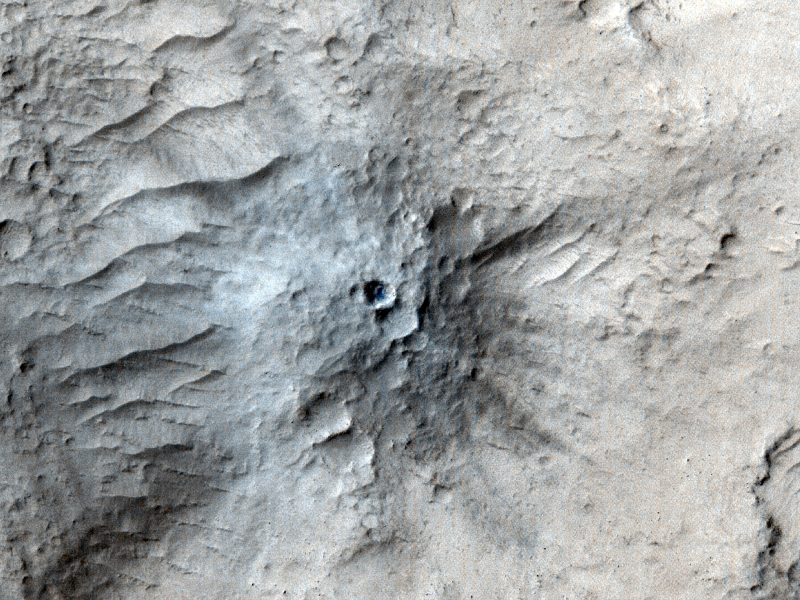“It was incredible” — researchers discover nearly 200 dinosaur footprints in England – Stewartville Star

In a remarkable paleontological discovery, researchers have unearthed hundreds of rare dinosaur footprints in a quarry located in Oxfordshire, United Kingdom. This groundbreaking find, dating back approximately 166 million years, has shed new light on the behavior and characteristics of ancient reptiles that once roamed the Earth.
Unveiling the prehistoric ‘dinosaur highway’
A team of scientists from the University of Birmingham and the University of Oxford have stumbled upon an extraordinary collection of dinosaur tracks, aptly dubbed a ‘dinosaur highway’. This rare discovery comprises nearly 200 individual footprints, preserved in mud for millions of years.
The most impressive aspect of this find is the continuous nature of the tracks. Unlike isolated footprints, researchers have uncovered five distinct trackways, with the longest stretching an impressive 150 meters in length. This unprecedented preservation allows paleontologists to gain valuable insights into dinosaur locomotion, social behavior, and ecology.
News
A watermelon-sized ice chunk falls from the sky and crashes into a sleeping couple’s bedroom.
The trackways were found in the following distribution:
Four tracks attributed to sauropods (likely Cetiosaurus)
One track believed to be from a Megalosaurus
Identifying the prehistoric track-makers
The footprints discovered in the Oxfordshire quarry have been attributed to two main types of dinosaurs:
Cetiosaurus: A long-necked herbivorous sauropod, reaching lengths of up to 18 meters
Megalosaurus: A carnivorous theropod, measuring approximately 9 meters in length
These identifications provide crucial information about the diversity of dinosaur species that inhabited the region during the Middle Jurassic period. The presence of both herbivores and carnivores in the same area suggests a complex ecosystem teeming with prehistoric life.
Dr. Duncan Murdock, an earth scientist at the Oxford University Museum of Natural History, emphasized the exceptional preservation of the tracks: “The preservation is so detailed that we can see how the mud was deformed as the dinosaurs’ feet squelched in and out.”
News
This is the exact amount of exercise you need per week to effectively lose weight
Unraveling prehistoric behaviors through fossilized footprints
The discovery of these dinosaur tracks offers paleontologists a unique opportunity to study various aspects of dinosaur biology and behavior. By analyzing the footprints, researchers can gain insights into:
Locomotion patterns
Walking and running speeds
Body size estimations
Potential social interactions
Professor Richard Butler from the University of Birmingham highlighted the significance of this find: “There is much more that we can learn from this site, which is an important part of our national Earth heritage.”
To facilitate further research and preserve this invaluable discovery, the team has created detailed 3D models of the trackways. These models will allow scientists worldwide to study the footprints and continue to unravel the mysteries of prehistoric life.
Ancient environment reconstruction
The dinosaur tracks provide more than just information about the animals themselves; they offer a glimpse into the environment of the Middle Jurassic period. Along with the footprints, researchers have discovered:
News
Forgotten in the plane’s cargo hold by the staff, a cat takes three trips between New Zealand and Australia.
Fossilized burrows
Shell remains
Plant fossils
This combination of evidence allows scientists to reconstruct the ancient landscape. Dr. Murdock explains: “Along with other fossils like burrows, shells and plants we can bring to life the muddy lagoon environment the dinosaurs walked through.”
The paleoenvironment can be summarized in the following table:
FeatureDescriptionLandscapeMuddy lagoonFloraVarious plant species (fossilized remains)FaunaDinosaurs, burrowing animals, shelled creaturesClimateLikely warm and humid
Serendipitous discovery and future prospects
The unearthing of this ‘dinosaur highway’ was a fortuitous event, sparked by the keen eye of quarry worker Gary Johnson. While operating a digger to strip clay from the quarry floor, Johnson noticed “unusual bumps” that turned out to be preserved dinosaur tracks.
This discovery builds upon previous findings in the area, including over 40 sets of footprints uncovered during limestone quarrying in 1997. The continuous nature of these newly found trackways provides an unprecedented opportunity to study dinosaur behavior and movement patterns.
As researchers continue to analyze the site, several key areas of focus emerge:
News
Researchers Thought They Discovered an Asteroid—It Was Elon Musk’s Tesla Floating in Space
Detailed mapping of individual trackways
Comparison with other known dinosaur track sites worldwide
Integration of footprint data with skeletal fossil evidence
Paleoecological reconstructions of the Middle Jurassic environment
The Oxfordshire quarry has become a treasure trove of paleontological information, offering a unique window into the distant past. As scientists delve deeper into the study of these rare dinosaur footprints, our understanding of prehistoric life continues to evolve, bringing us closer to unraveling the mysteries of Earth’s ancient inhabitants.
A team of scientists from the University of Birmingham and the University of Oxford have stumbled upon an extraordinary collection of dinosaur tracks, aptly dubbed a ‘dinosaur highway’. This rare discovery comprises nearly 200 individual footprints, preserved in mud for millions of years.
The most impressive aspect of this find is the continuous nature of the tracks. Unlike isolated footprints, researchers have uncovered five distinct trackways, with the longest stretching an impressive 150 meters in length. This unprecedented preservation allows paleontologists to gain valuable insights into dinosaur locomotion, social behavior, and ecology.
News
A watermelon-sized ice chunk falls from the sky and crashes into a sleeping couple’s bedroom.
The trackways were found in the following distribution:
Four tracks attributed to sauropods (likely Cetiosaurus)
One track believed to be from a Megalosaurus
Identifying the prehistoric track-makers
The footprints discovered in the Oxfordshire quarry have been attributed to two main types of dinosaurs:
Cetiosaurus: A long-necked herbivorous sauropod, reaching lengths of up to 18 meters
Megalosaurus: A carnivorous theropod, measuring approximately 9 meters in length
These identifications provide crucial information about the diversity of dinosaur species that inhabited the region during the Middle Jurassic period. The presence of both herbivores and carnivores in the same area suggests a complex ecosystem teeming with prehistoric life.
Dr. Duncan Murdock, an earth scientist at the Oxford University Museum of Natural History, emphasized the exceptional preservation of the tracks: “The preservation is so detailed that we can see how the mud was deformed as the dinosaurs’ feet squelched in and out.”
News
This is the exact amount of exercise you need per week to effectively lose weight
Unraveling prehistoric behaviors through fossilized footprints
The discovery of these dinosaur tracks offers paleontologists a unique opportunity to study various aspects of dinosaur biology and behavior. By analyzing the footprints, researchers can gain insights into:
Locomotion patterns
Walking and running speeds
Body size estimations
Potential social interactions
Professor Richard Butler from the University of Birmingham highlighted the significance of this find: “There is much more that we can learn from this site, which is an important part of our national Earth heritage.”
To facilitate further research and preserve this invaluable discovery, the team has created detailed 3D models of the trackways. These models will allow scientists worldwide to study the footprints and continue to unravel the mysteries of prehistoric life.
Ancient environment reconstruction
The dinosaur tracks provide more than just information about the animals themselves; they offer a glimpse into the environment of the Middle Jurassic period. Along with the footprints, researchers have discovered:
News
Forgotten in the plane’s cargo hold by the staff, a cat takes three trips between New Zealand and Australia.
Fossilized burrows
Shell remains
Plant fossils
This combination of evidence allows scientists to reconstruct the ancient landscape. Dr. Murdock explains: “Along with other fossils like burrows, shells and plants we can bring to life the muddy lagoon environment the dinosaurs walked through.”
The paleoenvironment can be summarized in the following table:
FeatureDescriptionLandscapeMuddy lagoonFloraVarious plant species (fossilized remains)FaunaDinosaurs, burrowing animals, shelled creaturesClimateLikely warm and humid
Serendipitous discovery and future prospects
The unearthing of this ‘dinosaur highway’ was a fortuitous event, sparked by the keen eye of quarry worker Gary Johnson. While operating a digger to strip clay from the quarry floor, Johnson noticed “unusual bumps” that turned out to be preserved dinosaur tracks.
This discovery builds upon previous findings in the area, including over 40 sets of footprints uncovered during limestone quarrying in 1997. The continuous nature of these newly found trackways provides an unprecedented opportunity to study dinosaur behavior and movement patterns.
As researchers continue to analyze the site, several key areas of focus emerge:
News
Researchers Thought They Discovered an Asteroid—It Was Elon Musk’s Tesla Floating in Space
Detailed mapping of individual trackways
Comparison with other known dinosaur track sites worldwide
Integration of footprint data with skeletal fossil evidence
Paleoecological reconstructions of the Middle Jurassic environment
The Oxfordshire quarry has become a treasure trove of paleontological information, offering a unique window into the distant past. As scientists delve deeper into the study of these rare dinosaur footprints, our understanding of prehistoric life continues to evolve, bringing us closer to unraveling the mysteries of Earth’s ancient inhabitants.
The most impressive aspect of this find is the continuous nature of the tracks. Unlike isolated footprints, researchers have uncovered five distinct trackways, with the longest stretching an impressive 150 meters in length. This unprecedented preservation allows paleontologists to gain valuable insights into dinosaur locomotion, social behavior, and ecology.
News
A watermelon-sized ice chunk falls from the sky and crashes into a sleeping couple’s bedroom.
The trackways were found in the following distribution:
Four tracks attributed to sauropods (likely Cetiosaurus)
One track believed to be from a Megalosaurus
Identifying the prehistoric track-makers
The footprints discovered in the Oxfordshire quarry have been attributed to two main types of dinosaurs:
Cetiosaurus: A long-necked herbivorous sauropod, reaching lengths of up to 18 meters
Megalosaurus: A carnivorous theropod, measuring approximately 9 meters in length
These identifications provide crucial information about the diversity of dinosaur species that inhabited the region during the Middle Jurassic period. The presence of both herbivores and carnivores in the same area suggests a complex ecosystem teeming with prehistoric life.
Dr. Duncan Murdock, an earth scientist at the Oxford University Museum of Natural History, emphasized the exceptional preservation of the tracks: “The preservation is so detailed that we can see how the mud was deformed as the dinosaurs’ feet squelched in and out.”
News
This is the exact amount of exercise you need per week to effectively lose weight
Unraveling prehistoric behaviors through fossilized footprints
The discovery of these dinosaur tracks offers paleontologists a unique opportunity to study various aspects of dinosaur biology and behavior. By analyzing the footprints, researchers can gain insights into:
Locomotion patterns
Walking and running speeds
Body size estimations
Potential social interactions
Professor Richard Butler from the University of Birmingham highlighted the significance of this find: “There is much more that we can learn from this site, which is an important part of our national Earth heritage.”
To facilitate further research and preserve this invaluable discovery, the team has created detailed 3D models of the trackways. These models will allow scientists worldwide to study the footprints and continue to unravel the mysteries of prehistoric life.
Ancient environment reconstruction
The dinosaur tracks provide more than just information about the animals themselves; they offer a glimpse into the environment of the Middle Jurassic period. Along with the footprints, researchers have discovered:
News
Forgotten in the plane’s cargo hold by the staff, a cat takes three trips between New Zealand and Australia.
Fossilized burrows
Shell remains
Plant fossils
This combination of evidence allows scientists to reconstruct the ancient landscape. Dr. Murdock explains: “Along with other fossils like burrows, shells and plants we can bring to life the muddy lagoon environment the dinosaurs walked through.”
The paleoenvironment can be summarized in the following table:
FeatureDescriptionLandscapeMuddy lagoonFloraVarious plant species (fossilized remains)FaunaDinosaurs, burrowing animals, shelled creaturesClimateLikely warm and humid
Serendipitous discovery and future prospects
The unearthing of this ‘dinosaur highway’ was a fortuitous event, sparked by the keen eye of quarry worker Gary Johnson. While operating a digger to strip clay from the quarry floor, Johnson noticed “unusual bumps” that turned out to be preserved dinosaur tracks.
This discovery builds upon previous findings in the area, including over 40 sets of footprints uncovered during limestone quarrying in 1997. The continuous nature of these newly found trackways provides an unprecedented opportunity to study dinosaur behavior and movement patterns.
As researchers continue to analyze the site, several key areas of focus emerge:
News
Researchers Thought They Discovered an Asteroid—It Was Elon Musk’s Tesla Floating in Space
Detailed mapping of individual trackways
Comparison with other known dinosaur track sites worldwide
Integration of footprint data with skeletal fossil evidence
Paleoecological reconstructions of the Middle Jurassic environment
The Oxfordshire quarry has become a treasure trove of paleontological information, offering a unique window into the distant past. As scientists delve deeper into the study of these rare dinosaur footprints, our understanding of prehistoric life continues to evolve, bringing us closer to unraveling the mysteries of Earth’s ancient inhabitants.
The footprints discovered in the Oxfordshire quarry have been attributed to two main types of dinosaurs:
Cetiosaurus: A long-necked herbivorous sauropod, reaching lengths of up to 18 meters
Megalosaurus: A carnivorous theropod, measuring approximately 9 meters in length
These identifications provide crucial information about the diversity of dinosaur species that inhabited the region during the Middle Jurassic period. The presence of both herbivores and carnivores in the same area suggests a complex ecosystem teeming with prehistoric life.
Dr. Duncan Murdock, an earth scientist at the Oxford University Museum of Natural History, emphasized the exceptional preservation of the tracks: “The preservation is so detailed that we can see how the mud was deformed as the dinosaurs’ feet squelched in and out.”
News
This is the exact amount of exercise you need per week to effectively lose weight
Unraveling prehistoric behaviors through fossilized footprints
The discovery of these dinosaur tracks offers paleontologists a unique opportunity to study various aspects of dinosaur biology and behavior. By analyzing the footprints, researchers can gain insights into:
Locomotion patterns
Walking and running speeds
Body size estimations
Potential social interactions
Professor Richard Butler from the University of Birmingham highlighted the significance of this find: “There is much more that we can learn from this site, which is an important part of our national Earth heritage.”
To facilitate further research and preserve this invaluable discovery, the team has created detailed 3D models of the trackways. These models will allow scientists worldwide to study the footprints and continue to unravel the mysteries of prehistoric life.
Ancient environment reconstruction
The dinosaur tracks provide more than just information about the animals themselves; they offer a glimpse into the environment of the Middle Jurassic period. Along with the footprints, researchers have discovered:
News
Forgotten in the plane’s cargo hold by the staff, a cat takes three trips between New Zealand and Australia.
Fossilized burrows
Shell remains
Plant fossils
This combination of evidence allows scientists to reconstruct the ancient landscape. Dr. Murdock explains: “Along with other fossils like burrows, shells and plants we can bring to life the muddy lagoon environment the dinosaurs walked through.”
The paleoenvironment can be summarized in the following table:
FeatureDescriptionLandscapeMuddy lagoonFloraVarious plant species (fossilized remains)FaunaDinosaurs, burrowing animals, shelled creaturesClimateLikely warm and humid
Serendipitous discovery and future prospects
The unearthing of this ‘dinosaur highway’ was a fortuitous event, sparked by the keen eye of quarry worker Gary Johnson. While operating a digger to strip clay from the quarry floor, Johnson noticed “unusual bumps” that turned out to be preserved dinosaur tracks.
This discovery builds upon previous findings in the area, including over 40 sets of footprints uncovered during limestone quarrying in 1997. The continuous nature of these newly found trackways provides an unprecedented opportunity to study dinosaur behavior and movement patterns.
As researchers continue to analyze the site, several key areas of focus emerge:
News
Researchers Thought They Discovered an Asteroid—It Was Elon Musk’s Tesla Floating in Space
Detailed mapping of individual trackways
Comparison with other known dinosaur track sites worldwide
Integration of footprint data with skeletal fossil evidence
Paleoecological reconstructions of the Middle Jurassic environment
The Oxfordshire quarry has become a treasure trove of paleontological information, offering a unique window into the distant past. As scientists delve deeper into the study of these rare dinosaur footprints, our understanding of prehistoric life continues to evolve, bringing us closer to unraveling the mysteries of Earth’s ancient inhabitants.
These identifications provide crucial information about the diversity of dinosaur species that inhabited the region during the Middle Jurassic period. The presence of both herbivores and carnivores in the same area suggests a complex ecosystem teeming with prehistoric life.
Dr. Duncan Murdock, an earth scientist at the Oxford University Museum of Natural History, emphasized the exceptional preservation of the tracks: “The preservation is so detailed that we can see how the mud was deformed as the dinosaurs’ feet squelched in and out.”
News
This is the exact amount of exercise you need per week to effectively lose weight
Unraveling prehistoric behaviors through fossilized footprints
The discovery of these dinosaur tracks offers paleontologists a unique opportunity to study various aspects of dinosaur biology and behavior. By analyzing the footprints, researchers can gain insights into:
Locomotion patterns
Walking and running speeds
Body size estimations
Potential social interactions
Professor Richard Butler from the University of Birmingham highlighted the significance of this find: “There is much more that we can learn from this site, which is an important part of our national Earth heritage.”
To facilitate further research and preserve this invaluable discovery, the team has created detailed 3D models of the trackways. These models will allow scientists worldwide to study the footprints and continue to unravel the mysteries of prehistoric life.
Ancient environment reconstruction
The dinosaur tracks provide more than just information about the animals themselves; they offer a glimpse into the environment of the Middle Jurassic period. Along with the footprints, researchers have discovered:
News
Forgotten in the plane’s cargo hold by the staff, a cat takes three trips between New Zealand and Australia.
Fossilized burrows
Shell remains
Plant fossils
This combination of evidence allows scientists to reconstruct the ancient landscape. Dr. Murdock explains: “Along with other fossils like burrows, shells and plants we can bring to life the muddy lagoon environment the dinosaurs walked through.”
The paleoenvironment can be summarized in the following table:
FeatureDescriptionLandscapeMuddy lagoonFloraVarious plant species (fossilized remains)FaunaDinosaurs, burrowing animals, shelled creaturesClimateLikely warm and humid
Serendipitous discovery and future prospects
The unearthing of this ‘dinosaur highway’ was a fortuitous event, sparked by the keen eye of quarry worker Gary Johnson. While operating a digger to strip clay from the quarry floor, Johnson noticed “unusual bumps” that turned out to be preserved dinosaur tracks.
This discovery builds upon previous findings in the area, including over 40 sets of footprints uncovered during limestone quarrying in 1997. The continuous nature of these newly found trackways provides an unprecedented opportunity to study dinosaur behavior and movement patterns.
As researchers continue to analyze the site, several key areas of focus emerge:
News
Researchers Thought They Discovered an Asteroid—It Was Elon Musk’s Tesla Floating in Space
Detailed mapping of individual trackways
Comparison with other known dinosaur track sites worldwide
Integration of footprint data with skeletal fossil evidence
Paleoecological reconstructions of the Middle Jurassic environment
The Oxfordshire quarry has become a treasure trove of paleontological information, offering a unique window into the distant past. As scientists delve deeper into the study of these rare dinosaur footprints, our understanding of prehistoric life continues to evolve, bringing us closer to unraveling the mysteries of Earth’s ancient inhabitants.
Dr. Duncan Murdock, an earth scientist at the Oxford University Museum of Natural History, emphasized the exceptional preservation of the tracks: “The preservation is so detailed that we can see how the mud was deformed as the dinosaurs’ feet squelched in and out.”
News
This is the exact amount of exercise you need per week to effectively lose weight
The discovery of these dinosaur tracks offers paleontologists a unique opportunity to study various aspects of dinosaur biology and behavior. By analyzing the footprints, researchers can gain insights into:
Locomotion patterns
Walking and running speeds
Body size estimations
Potential social interactions
Professor Richard Butler from the University of Birmingham highlighted the significance of this find: “There is much more that we can learn from this site, which is an important part of our national Earth heritage.”
To facilitate further research and preserve this invaluable discovery, the team has created detailed 3D models of the trackways. These models will allow scientists worldwide to study the footprints and continue to unravel the mysteries of prehistoric life.
Ancient environment reconstruction
The dinosaur tracks provide more than just information about the animals themselves; they offer a glimpse into the environment of the Middle Jurassic period. Along with the footprints, researchers have discovered:
News
Forgotten in the plane’s cargo hold by the staff, a cat takes three trips between New Zealand and Australia.
Fossilized burrows
Shell remains
Plant fossils
This combination of evidence allows scientists to reconstruct the ancient landscape. Dr. Murdock explains: “Along with other fossils like burrows, shells and plants we can bring to life the muddy lagoon environment the dinosaurs walked through.”
The paleoenvironment can be summarized in the following table:
FeatureDescriptionLandscapeMuddy lagoonFloraVarious plant species (fossilized remains)FaunaDinosaurs, burrowing animals, shelled creaturesClimateLikely warm and humid
Serendipitous discovery and future prospects
The unearthing of this ‘dinosaur highway’ was a fortuitous event, sparked by the keen eye of quarry worker Gary Johnson. While operating a digger to strip clay from the quarry floor, Johnson noticed “unusual bumps” that turned out to be preserved dinosaur tracks.
This discovery builds upon previous findings in the area, including over 40 sets of footprints uncovered during limestone quarrying in 1997. The continuous nature of these newly found trackways provides an unprecedented opportunity to study dinosaur behavior and movement patterns.
As researchers continue to analyze the site, several key areas of focus emerge:
News
Researchers Thought They Discovered an Asteroid—It Was Elon Musk’s Tesla Floating in Space
Detailed mapping of individual trackways
Comparison with other known dinosaur track sites worldwide
Integration of footprint data with skeletal fossil evidence
Paleoecological reconstructions of the Middle Jurassic environment
The Oxfordshire quarry has become a treasure trove of paleontological information, offering a unique window into the distant past. As scientists delve deeper into the study of these rare dinosaur footprints, our understanding of prehistoric life continues to evolve, bringing us closer to unraveling the mysteries of Earth’s ancient inhabitants.
Professor Richard Butler from the University of Birmingham highlighted the significance of this find: “There is much more that we can learn from this site, which is an important part of our national Earth heritage.”
To facilitate further research and preserve this invaluable discovery, the team has created detailed 3D models of the trackways. These models will allow scientists worldwide to study the footprints and continue to unravel the mysteries of prehistoric life.
Ancient environment reconstruction
The dinosaur tracks provide more than just information about the animals themselves; they offer a glimpse into the environment of the Middle Jurassic period. Along with the footprints, researchers have discovered:
News
Forgotten in the plane’s cargo hold by the staff, a cat takes three trips between New Zealand and Australia.
Fossilized burrows
Shell remains
Plant fossils
This combination of evidence allows scientists to reconstruct the ancient landscape. Dr. Murdock explains: “Along with other fossils like burrows, shells and plants we can bring to life the muddy lagoon environment the dinosaurs walked through.”
The paleoenvironment can be summarized in the following table:
FeatureDescriptionLandscapeMuddy lagoonFloraVarious plant species (fossilized remains)FaunaDinosaurs, burrowing animals, shelled creaturesClimateLikely warm and humid
Serendipitous discovery and future prospects
The unearthing of this ‘dinosaur highway’ was a fortuitous event, sparked by the keen eye of quarry worker Gary Johnson. While operating a digger to strip clay from the quarry floor, Johnson noticed “unusual bumps” that turned out to be preserved dinosaur tracks.
This discovery builds upon previous findings in the area, including over 40 sets of footprints uncovered during limestone quarrying in 1997. The continuous nature of these newly found trackways provides an unprecedented opportunity to study dinosaur behavior and movement patterns.
As researchers continue to analyze the site, several key areas of focus emerge:
News
Researchers Thought They Discovered an Asteroid—It Was Elon Musk’s Tesla Floating in Space
Detailed mapping of individual trackways
Comparison with other known dinosaur track sites worldwide
Integration of footprint data with skeletal fossil evidence
Paleoecological reconstructions of the Middle Jurassic environment
The Oxfordshire quarry has become a treasure trove of paleontological information, offering a unique window into the distant past. As scientists delve deeper into the study of these rare dinosaur footprints, our understanding of prehistoric life continues to evolve, bringing us closer to unraveling the mysteries of Earth’s ancient inhabitants.
To facilitate further research and preserve this invaluable discovery, the team has created detailed 3D models of the trackways. These models will allow scientists worldwide to study the footprints and continue to unravel the mysteries of prehistoric life.
Ancient environment reconstruction
The dinosaur tracks provide more than just information about the animals themselves; they offer a glimpse into the environment of the Middle Jurassic period. Along with the footprints, researchers have discovered:
News
Forgotten in the plane’s cargo hold by the staff, a cat takes three trips between New Zealand and Australia.
Fossilized burrows
Shell remains
Plant fossils
This combination of evidence allows scientists to reconstruct the ancient landscape. Dr. Murdock explains: “Along with other fossils like burrows, shells and plants we can bring to life the muddy lagoon environment the dinosaurs walked through.”
The paleoenvironment can be summarized in the following table:
FeatureDescriptionLandscapeMuddy lagoonFloraVarious plant species (fossilized remains)FaunaDinosaurs, burrowing animals, shelled creaturesClimateLikely warm and humid
Serendipitous discovery and future prospects
The unearthing of this ‘dinosaur highway’ was a fortuitous event, sparked by the keen eye of quarry worker Gary Johnson. While operating a digger to strip clay from the quarry floor, Johnson noticed “unusual bumps” that turned out to be preserved dinosaur tracks.
This discovery builds upon previous findings in the area, including over 40 sets of footprints uncovered during limestone quarrying in 1997. The continuous nature of these newly found trackways provides an unprecedented opportunity to study dinosaur behavior and movement patterns.
As researchers continue to analyze the site, several key areas of focus emerge:
News
Researchers Thought They Discovered an Asteroid—It Was Elon Musk’s Tesla Floating in Space
Detailed mapping of individual trackways
Comparison with other known dinosaur track sites worldwide
Integration of footprint data with skeletal fossil evidence
Paleoecological reconstructions of the Middle Jurassic environment
The Oxfordshire quarry has become a treasure trove of paleontological information, offering a unique window into the distant past. As scientists delve deeper into the study of these rare dinosaur footprints, our understanding of prehistoric life continues to evolve, bringing us closer to unraveling the mysteries of Earth’s ancient inhabitants.
The dinosaur tracks provide more than just information about the animals themselves; they offer a glimpse into the environment of the Middle Jurassic period. Along with the footprints, researchers have discovered:
News
Forgotten in the plane’s cargo hold by the staff, a cat takes three trips between New Zealand and Australia.
This combination of evidence allows scientists to reconstruct the ancient landscape. Dr. Murdock explains: “Along with other fossils like burrows, shells and plants we can bring to life the muddy lagoon environment the dinosaurs walked through.”
The paleoenvironment can be summarized in the following table:
FeatureDescriptionLandscapeMuddy lagoonFloraVarious plant species (fossilized remains)FaunaDinosaurs, burrowing animals, shelled creaturesClimateLikely warm and humid
Serendipitous discovery and future prospects
The unearthing of this ‘dinosaur highway’ was a fortuitous event, sparked by the keen eye of quarry worker Gary Johnson. While operating a digger to strip clay from the quarry floor, Johnson noticed “unusual bumps” that turned out to be preserved dinosaur tracks.
This discovery builds upon previous findings in the area, including over 40 sets of footprints uncovered during limestone quarrying in 1997. The continuous nature of these newly found trackways provides an unprecedented opportunity to study dinosaur behavior and movement patterns.
As researchers continue to analyze the site, several key areas of focus emerge:
News
Researchers Thought They Discovered an Asteroid—It Was Elon Musk’s Tesla Floating in Space
Detailed mapping of individual trackways
Comparison with other known dinosaur track sites worldwide
Integration of footprint data with skeletal fossil evidence
Paleoecological reconstructions of the Middle Jurassic environment
The Oxfordshire quarry has become a treasure trove of paleontological information, offering a unique window into the distant past. As scientists delve deeper into the study of these rare dinosaur footprints, our understanding of prehistoric life continues to evolve, bringing us closer to unraveling the mysteries of Earth’s ancient inhabitants.
The paleoenvironment can be summarized in the following table:
FeatureDescriptionLandscapeMuddy lagoonFloraVarious plant species (fossilized remains)FaunaDinosaurs, burrowing animals, shelled creaturesClimateLikely warm and humid
Serendipitous discovery and future prospects
The unearthing of this ‘dinosaur highway’ was a fortuitous event, sparked by the keen eye of quarry worker Gary Johnson. While operating a digger to strip clay from the quarry floor, Johnson noticed “unusual bumps” that turned out to be preserved dinosaur tracks.
This discovery builds upon previous findings in the area, including over 40 sets of footprints uncovered during limestone quarrying in 1997. The continuous nature of these newly found trackways provides an unprecedented opportunity to study dinosaur behavior and movement patterns.
As researchers continue to analyze the site, several key areas of focus emerge:
News
Researchers Thought They Discovered an Asteroid—It Was Elon Musk’s Tesla Floating in Space
Detailed mapping of individual trackways
Comparison with other known dinosaur track sites worldwide
Integration of footprint data with skeletal fossil evidence
Paleoecological reconstructions of the Middle Jurassic environment
The Oxfordshire quarry has become a treasure trove of paleontological information, offering a unique window into the distant past. As scientists delve deeper into the study of these rare dinosaur footprints, our understanding of prehistoric life continues to evolve, bringing us closer to unraveling the mysteries of Earth’s ancient inhabitants.
The unearthing of this ‘dinosaur highway’ was a fortuitous event, sparked by the keen eye of quarry worker Gary Johnson. While operating a digger to strip clay from the quarry floor, Johnson noticed “unusual bumps” that turned out to be preserved dinosaur tracks.
This discovery builds upon previous findings in the area, including over 40 sets of footprints uncovered during limestone quarrying in 1997. The continuous nature of these newly found trackways provides an unprecedented opportunity to study dinosaur behavior and movement patterns.
As researchers continue to analyze the site, several key areas of focus emerge:
News
Researchers Thought They Discovered an Asteroid—It Was Elon Musk’s Tesla Floating in Space
Detailed mapping of individual trackways
Comparison with other known dinosaur track sites worldwide
Integration of footprint data with skeletal fossil evidence
Paleoecological reconstructions of the Middle Jurassic environment
The Oxfordshire quarry has become a treasure trove of paleontological information, offering a unique window into the distant past. As scientists delve deeper into the study of these rare dinosaur footprints, our understanding of prehistoric life continues to evolve, bringing us closer to unraveling the mysteries of Earth’s ancient inhabitants.
This discovery builds upon previous findings in the area, including over 40 sets of footprints uncovered during limestone quarrying in 1997. The continuous nature of these newly found trackways provides an unprecedented opportunity to study dinosaur behavior and movement patterns.
As researchers continue to analyze the site, several key areas of focus emerge:
News
Researchers Thought They Discovered an Asteroid—It Was Elon Musk’s Tesla Floating in Space
Detailed mapping of individual trackways
Comparison with other known dinosaur track sites worldwide
Integration of footprint data with skeletal fossil evidence
Paleoecological reconstructions of the Middle Jurassic environment
The Oxfordshire quarry has become a treasure trove of paleontological information, offering a unique window into the distant past. As scientists delve deeper into the study of these rare dinosaur footprints, our understanding of prehistoric life continues to evolve, bringing us closer to unraveling the mysteries of Earth’s ancient inhabitants.
As researchers continue to analyze the site, several key areas of focus emerge:
News
Researchers Thought They Discovered an Asteroid—It Was Elon Musk’s Tesla Floating in Space
The Oxfordshire quarry has become a treasure trove of paleontological information, offering a unique window into the distant past. As scientists delve deeper into the study of these rare dinosaur footprints, our understanding of prehistoric life continues to evolve, bringing us closer to unraveling the mysteries of Earth’s ancient inhabitants.
Thinking gardening is one of the best meditating method, I also like writing about psychology.Comment
ΔStewartville StarContact© 2025 Stewartville Star






